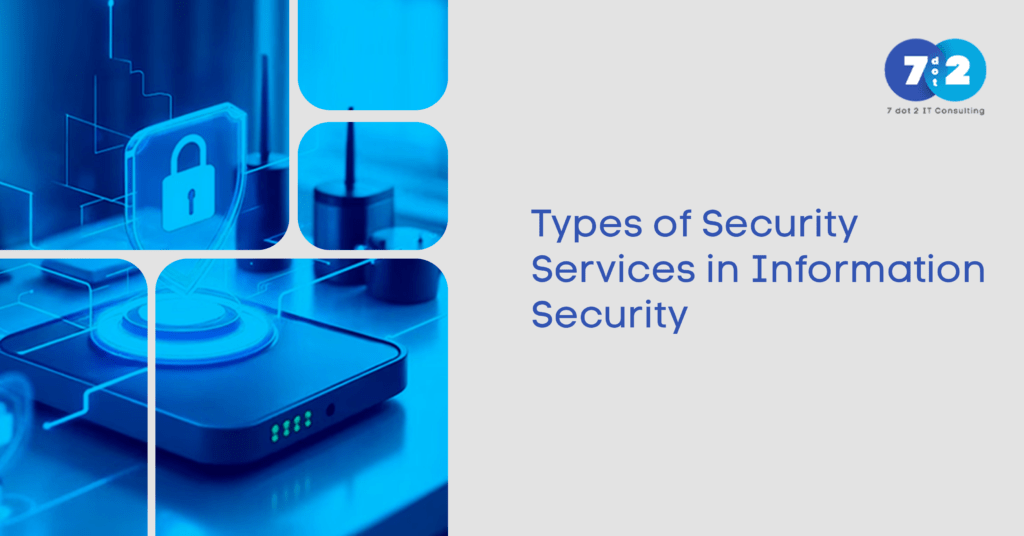Types of Security Services in Information Security
Posted on : 16 November 2024 at 10:31 am, by Puneet Aggarwal, Founder 7 dot 2 IT Consulting

In an increasingly interconnected and expanding digital landscape, safeguarding information is more vital than ever. Cyber threats are evolving rapidly, and without the right protection, they can wreak havoc on both individuals and organizations. This is where security services in information security play a crucial role.
These services are the cornerstone of a secure digital environment. They include a wide range of technologies and protocols like firewalls, encryption, authentication, and more. Each designed to protect data, maintain system integrity, and ensure availability. In this blog, we’ll explore the types of security services, their key components, and their role in shielding digital assets.
What Are Security Services in Information Security?
Security services refer to structured processes and mechanisms implemented to protect information systems from threats and vulnerabilities. They aim to uphold the CIA triad which is Confidentiality, Integrity, and Availability, while ensuring that data is only accessible, accurate, and available to authorized individuals. Here’s the breakdown of the functionality of Security Services in Information Security.
1. Confidentiality: Ensures sensitive data is accessible only to authorized users.
2. Integrity: Guarantees that information remains accurate and unaltered.
3. Availability: Makes sure data and systems are accessible when needed.
Key Types of Security Services
Let’s look at some of the important types of security services in Information Security:
1. Authentication: Authentication verifies the identity of users or devices before granting access to systems or data.
a) Passwords/PINs: The most basic form of security, where users provide a secret code to verify identity.
b) Biometrics: Uses unique biological traits like fingerprints or facial features for high-assurance authentication.
c) Two-Factor Authentication (2FA): Combines two methods, like a password and a mobile-generated code, for enhanced security.
2. Authorization: Authorization determines what actions or data an authenticated user is permitted to access.
a) Role-Based Access Control (RBAC): Grants permissions based on user roles within an organization.
b) Discretionary Access Control (DAC): Lets data owners decide who has access.
c) Mandatory Access Control (MAC): Access is governed by strict policies enforced by the system.
3. Confidentiality: Confidentiality safeguards sensitive data from unauthorized disclosure.
a) Data Encryption: Converts plain data into unreadable code, only accessible via decryption keys.
b) Secure Channels (HTTPS/SSL): Protect data during transmission from interception and eavesdropping.
4. Integrity: Integrity ensures that data is accurate and has not been altered by unauthorized entities.
a) Hashing: Converts data into a fixed-length string to detect changes.
b) Checksums: Validate data integrity during transmission or changes.
5. Non-repudiation: Non-repudiation provides proof of the origin and delivery of data, preventing denial of responsibility.
a) Digital Signatures: Encrypt a unique signature with the sender’s private key for changes.
b) Audit Logs: Record user activity for traceability and forensic changes.
Why Are Security Services Important?
Here are some of the key reasons to value security services:
1. Protection of Sensitive Data: They prevent unauthorized access to private and critical data, ensuring privacy and security.
2. Compliance with Regulations: Security services help meet regulatory requirements like GDPR, HIPAA, and ISO standards.
3. Business Continuity: They reduce the risk of downtime from cyber-attacks, supporting seamless operations.
4. Preventing Financial Loss: Data breaches can cost millions—security services mitigate these risks effectively.
Best Practices for Implementing Security Services
Below are few of the best practices for implementing security services.
1. Conduct Regular Security Audits: Frequent assessments help identify and patch vulnerabilities before exploitation.
2. Employee Training and Awareness: Educated employees are less likely to fall for phishing or social engineering attacks.
3. Use of Multi-Factor Authentication (MFA): Adds an extra security layer by combining multiple verification methods.
4. Continuous Monitoring: Real-time oversight of systems helps quickly detect and contain breaches.
5. Regular Updates and Patch Management: Timely updates and patches prevent exploits from known vulnearbilities.
Challenges in Security Services
Consider the following challenges before implementing security services.
1. Rapidly Evolving Threats: New attack methods constantly emerge, requiring adaptive security measures.
2. Complexity of Implementation: Integrating various security solutions can be challenging for organizations.
3. Balancing Security and Usability: Overly strict controls may hinder usability and user satisfaction.
4. Cost of Security Solutions: Robust solutions can be expensive, particularly for smaller organizations.
Conclusion
Security services are the bedrock of a secure and trustworthy digital environment. As cyber threats become more sophisticated, implementing robust security mechanisms is no longer optional but essential. From ensuring data confidentiality to providing proof of transaction authenticity, these services form a holistic defense system.
By embracing security best practices and evolving alongside the threat landscape, businesses and individuals alike can ensure the resilience and safety of their digital assets. At 7dot2, we specialize in delivering cutting-edge IT consulting and cybersecurity solutions tailored to today’s dynamic digital landscape!
